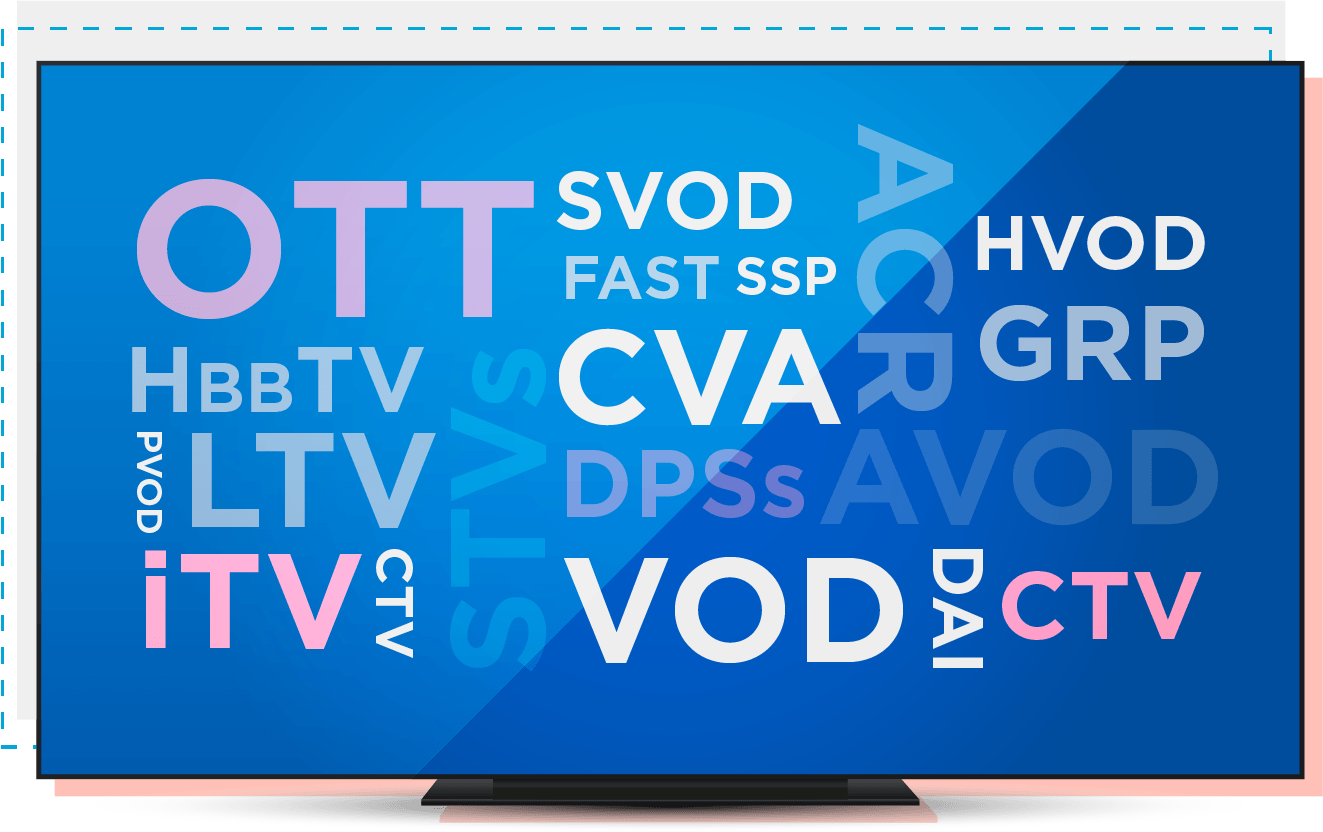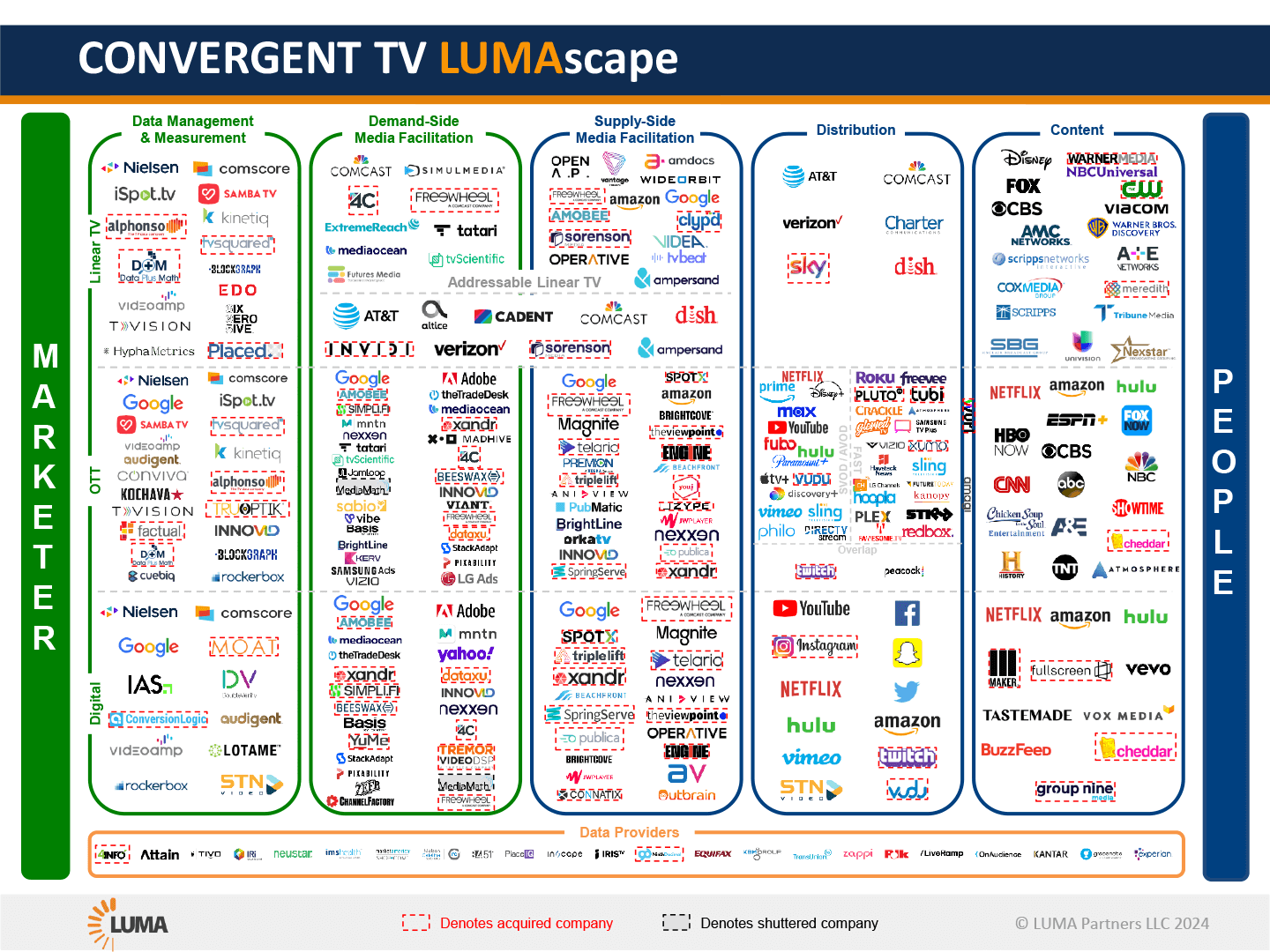Key over-the-top (OTT) and connected TV (CTV) terminology
The world of television has undergone a dramatic transformation, moving away from traditional broadcast methods to embrace internet-connected devices that deliver streaming content. This paradigm is known as Advanced TV—the evolution of television viewing and advertising beyond traditional linear TV. Advanced TV comprises a range of technologies and platforms, including connected TV (CTV), over-the-top (OTT) streaming services, addressable TV, and programmatic TV. It provides a more flexible and measurable approach to advertising, bridging the gap between digital and traditional TV landscapes. This enables advertisers to deliver more targeted and personalized ads by leveraging data-driven insights, enhancing viewer engagement and improving ad effectiveness.
Advanced TV has given rise to a plethora of new CVA (concepts, vocabulary & acronyms—see what we did there?) that are often bewildering. As you peruse this guide, you will encounter a range of advanced TV advertising terms that define this dynamic space. Our goal is to demystify so much alphabet soup, offering straightforward definitions and illustrative examples to enhance your advanced TV understanding. We aim to convey the knowledge needed to navigate and understand the intricacies of OTT and CTV, empowering you to engage confidently with this exciting field.

At the outset, understanding the foundational concepts of OTT and CTV is crucial for marketers looking to leverage these platforms effectively. It is important to define the key definitions and distinctions between over-the-top (OTT) content delivery and connected TV (CTV) hardware, setting the stage for a deeper exploration of how state-of-the-art advanced TV interfaces with audiences and marketers in innovative ways—and for the parade of words and definitions to follow.
OTT (Over-the-Top)
Over-the-Top, or OTT, describes the method of delivering television and film content directly to viewers, streamed “over the top” of the internet and thus bypassing traditional broadcast, cable, or satellite platforms. OTT content can be accessed from apps or websites via a variety of devices, including connected TVs, desktops or laptops, mobile phones, and tablets. OTT represents the content delivery aspect of the advanced TV ecosystem, offering viewers the flexibility to watch what they want, when they want, on their preferred device.
CTV (Connected TV)
CTV, or connected TV, describes televisions that are either directly internet-enabled, such as smart TVs, or those that use external devices to stream content over the internet. These devices include streaming media players (Roku, Amazon Fire TV, Apple TV, Chromecast with Google TV); smart TV operating systems (Samsung, LG, VIZIO, Roku); and gaming consoles (PlayStation, Xbox). The CTV ecosystem also encompasses various streaming services: subscription-based services (Netflix, Disney+, Max, Amazon Prime Video); hybrid services combining subscription and ad-supported models (Hulu, Peacock, Paramount+); and free ad-supported streaming television (FAST) services (Pluto TV, Tubi, Freevee, Xumo Play, Plex, the Roku Channel). CTV represents the hardware aspect of the advanced TV ecosystem, providing the means to access a wide array of OTT streaming services and content.

With the stage now set, the rest of the terms appear in alphabetical order. Enjoy!
ACR (Automatic Content Recognition)
ACR is a technology built into smart TVs that identifies in real-time the content playing onscreen, whether from streaming services, gaming consoles, or even traditional cable boxes. This enables more precise audience measurement and ad targeting in the CTV environment. ACR helps advertisers understand what content viewers are watching as well as which ads they are exposed to, making it a cornerstone technology for advanced TV advertising measurement, viewability, and frequency management.
Ad Pods
Ad pods are groups of ads that play back-to-back during a commercial break in a video stream. Advertisers can optimize these pods for efficiency by rotating ads or showing them in specific sequences.
Addressable Advertising
Addressable advertising in the advanced TV ecosystem enables different ads to be shown to different households watching the same program, based on sophisticated targeting capabilities. This technology has evolved far beyond basic demographic targeting (i.e., age and gender) to incorporate multiple layers of audience intelligence. Advertisers can now reach viewers based on affluence, education, and life stage indicators, as well as behavioral patterns such as viewing habits and content preferences. Geographic precision ranges from broad DMA (designated market area) coverage down to specific zip codes or neighborhoods, effecting locally relevant messaging. Addressable advertising also considers interest-based factors, analyzing data about hobbies, purchase intentions, and lifestyle choices to ensure ad relevancy. Brands can create custom audience segments using first-party data or specific brand criteria, with the ability to adjust targeting mid-campaign based on performance metrics. This dynamic approach ensures optimal audience reach and campaign effectiveness in ways traditional TV advertising could never achieve.
Addressable TV
Addressable TV uses programmatic technology to segment audiences automatically to target ads at the household level. These addressable TV advertisements are served to viewers across set-top providers (cable platforms) and VOD (video on demand) inventory in real-time. Addressable TV enables advertisers to target customers and geographies more precisely.
Advanced TV Advertising
Advanced TV advertising refers to the delivery of ads on television sets that are connected to the internet, through streaming devices (Roku, Amazon Fire TV, Apple TV, Chromecast with Google TV), smart TV platforms (Samsung, LG, VIZIO), and gaming consoles. This innovative form of advertising enables brands to serve targeted, often interactive ads to viewers who consume content via CTV platforms and OTT streaming services.
ATSC 3.0
ATSC 3.0 is the latest version of Advanced Television Systems Committee standards for broadcast television, also known as NEXTGEN TV. It combines over-the-air broadcasting with broadband internet, revolutionizing both viewing experiences and advertising capabilities. For viewers, ATSC 3.0 delivers 4K ultra high-definition video quality, theater-like sound, mobile reception, and enhanced emergency alerts. For advertisers, it enables breakthrough capabilities including dynamic ad insertion at the household level, geographic targeting down to neighborhoods, interactive advertising overlays, and real-time ad performance measurement. The standard also supports dialogue replacement that enables broadcasters to customize audio elements of ads for different audiences. This convergence of broadcast and digital creates new opportunities for advertisers to deliver personalized experiences while maintaining the broad reach of traditional television.
AVOD (Advertising-Based Video on Demand)
AVOD is a streaming service model that offers free, ad-supported streaming video (Tubi, Freevee, Pluto TV, Xumo Play, Plex, the Roku Channel). Some hybrid streaming services (Peacock, Paramount+, Hulu) also offer ad-supported tiers alongside their subscription options. Viewers can watch content for free, but advertisements occasionally appear during their view time.
Channel Stores
Channel Stores are app distribution platforms where viewers can launch various streaming channels through a single interface. Major examples include Amazon Channels, the Roku Channel Store, Apple TV Channels, and Samsung TV Plus Video. These aggregation platforms offer viewers a convenient means to access and subscribe to different content providers within the advanced TV ecosystem, often with unified billing and content discovery.
Digital TV
Digital TV transmits television signals across digital media such as desktop, mobile, or tablets rather than traditional linear television delivery.
DAI (Dynamic Ad Insertion)
DAI technology enables advertisers to insert ads into a video stream in real-time based on viewer data, device information, and content context. Unlike traditional linear TV advertising, where the same ads broadcast to all viewers, DAI creates individual decision points within the content stream where customized ads can be inserted. This process happens in two main ways: client-side DAI (CSAI), where the insertion occurs on the viewer’s device, or server-side DAI (SSAI), where ads are stitched into the content stream before delivery. DAI technology considers factors such as viewer demographics, viewing history, geographic location, and even time of day to determine the most relevant ad to serve. This capability is particularly powerful in OTT/CTV environments, combining the high-quality viewing experience of traditional TV with the targeting precision of digital advertising.
FAST (Free Ad Supported TV)
FAST refers to a growing category of streaming services that offer content for free, supported by advertisements. This model is similar to AVOD (advertising-based video on demand), but differs from it in that FAST services are often pre-programmed channels, similar to linear TV. Examples include Pluto TV, Tubi, Freevee, Xumo Play, Plex, and channels from connected TV OEMs such as the Roku Channel, Samsung TV Plus, LG Channels, and VIZIO WatchFree+.
Frequency Capping
Frequency capping in CTV refers to the practice of limiting how often a specific household sees the same advertisement across different streaming platforms and services. This is particularly important in the CTV space where multiple family members might be watching through different apps on the same device or the same content might be accessed through different CTV devices in the home. Effective frequency capping helps optimize campaign spending and prevent ad fatigue.
GRP (Gross Rating Point)
GRP is a standard measure in advertising used to quantify the exposure of an ad by measuring impressions as a percentage of the target population. GRP refers to the total exposure as a percentage of the target audience.
HbbTV (Hybrid Broadcast Broadband TV)
HbbTV is a global initiative aimed at harmonizing broadcast TV and broadband delivery of entertainment services to consumers, allowing connected TVs, set-top boxes, and multiscreen devices to access additional online services and content alongside traditional broadcasts.
Household Graph
A household graph is a data structure that maps the relationship between CTV devices, viewers, and households, enabling advertisers to understand and reach specific audiences at the household level. This technology helps solve one of the unique challenges of CTV advertising: multiple viewers using the same device or multiple devices in the same household. Household graphs enable more precise targeting and measurement while respecting viewer privacy, making them essential for advanced TV advertising campaigns.
HVOD (Hybrid Video on Demand)
HVOD combines elements of SVOD and AVOD, offering a hybrid of subscription-based and ad-supported content. Subscribers have the option to pay a higher subscription rate for an ad-free experience or a lower rate for an experience that includes ads. In recent years, SVOD streaming services such as Netflix and Disney+, which previously offered only ad-free subscriptions, have introduced subscription tiers with ad-supported content at a lower price point.
iTV (Interactive TV)
iTV refers to television services that enable viewers to interact with the content they are watching, such as voting, shopping, or accessing additional information, making TV a more interactive medium.
Linear TV
Linear TV is the traditional television form factor in which networks broadcast content that is displayed via a satellite or cable box and watched live at a scheduled time on a specific channel.
MVPD (Multichannel Video Program Distributor)
A MVPD (Comcast, Spectrum, DISH Network) distributes or serves multiple television channels to viewers via cable, satellite, or other distribution technologies. They typically offer bundled packages of channels, typically on a subscription basis, and may also offer video-on-demand.
Programmatic Advertising
Programmatic advertising is the automated process of buying and selling digital advertising using software algorithms rather than traditional human negotiations and manual insertion orders. In the CTV/OTT space, programmatic advertising has seen explosive growth, with market statistics showing that programmatic CTV ad spend reached $19 billion in 2023 and is projected to exceed $25 billion in 2025. This growth is driven by improved targeting capabilities atop the shift in viewer behavior toward streaming platforms. Programmatic technology enables advertisers to purchase individual impressions in real-time while optimizing for specific audience segments, content types, and viewing contexts. Success rates show that programmatic CTV campaigns typically achieve up to 80% completion rates, significantly higher than traditional digital video advertising. This efficiency, combined with the precision of audience targeting, has made programmatic the preferred method for most advanced TV advertising campaigns.
Programmatic TV
Programmatic TV is the automated process of buying, selling, and delivering television ads using data-driven software and real-time bidding technologies. Unlike traditional TV ad buying, which relies on broad demographic data and manual insertion orders, programmatic TV leverages viewing data from set-top boxes (STBs) and smart TVs to identify and reach specific audience segments. The process works through several key components: demand-side platforms (DSPs) that enable buyers to manage campaigns across multiple inventory sources, supply-side platforms (SSPs) that help publishers optimize ad inventory, and data management platforms (DMPs) that organize and activate audience data. In CTV environments, programmatic TV factors in variables such as content genre, viewing time, device type, and household characteristics to make near real-time decisions about which ads to serve. This technology enables advertisers to move beyond traditional age and gender targeting to reach audiences based on behaviors, interests, and purchase intent, while maintaining the brand-safe environment of television.
PVOD (Premium Video on Demand)
PVOD enables consumers to purchase early access to content prior to, simultaneously with, or shortly after its theatrical release. Users can pay a one-time fee in addition to their monthly subscription to access new content before it’s available on other platforms. PVOD is often used for highly anticipated/high-budget films or unreleased movies. PVOD provides an alternative to movie theaters, enabling studios to monetize their films outside of traditional theatrical releases.
SSAI (Server-Side Ad Insertion)
SSAI, also known as dynamic ad stitching, is a technology that seamlessly integrates ads into streaming content at the server level before it reaches the viewer’s device. Unlike client-side ad insertion, SSAI provides a smoother viewing experience that mimics traditional TV. This technology is crucial for OTT and CTV platforms, as it helps ensure reliable ad delivery and reduces buffering between content and advertisements.
SVOD (Subscription Video on Demand)
SVOD describes streaming services (Netflix, Disney+, Max, Amazon Prime Video, Apple TV+) that require viewers to pay a subscription fee, usually at a monthly rate. Viewers can then watch shows from a library of content whenever they choose. While traditionally SVOD services were ad-free, some services now offer both ad-free premium tiers and lower-priced ad-supported options (Hulu, Peacock, Paramount+, Netflix).
t-Commerce (Television Commerce)
t-Commerce involves purchasing products directly through TV platforms. Advanced TV technologies have facilitated commercial interactions as an evolving way that viewers interact with TV content.
Target Rating Point (TRP)
TRP is a standard metric in advertising used to quantify ad exposure, focusing on a specific demographic or target audience. Similar to GRP.
Traditional TV
Traditional TV is the OG means of ad buying in which ad spots are purchased based on viewer data such as gender, age, and other demographics, then served on specific TV ad programs. This type of ad buying reaches a wide range of viewers across linear TV ad spots.
TV Buying
TV buying is the process of purchasing ad space and time on a platform or service to target specific audiences for increasing a customer base. TV buying has evolved over the years: Traditionally, ads were purchased and displayed on cable/satellite television, reaching broad audiences. Now, ad space can be bought and sold automatically, served to specific viewers across many programs and devices.

TV Content
TV content refers to how television can be made available to viewers. Instead of paying for cable or satellite services and watching content available only on the channels provided, viewers can decide what content they want to view and pay for that content in various ways. Advertisers can also determine what type of TV content they serve ads on depending on the audiences they want to target.
There are many types of TV content, and each platform can have a combination of features. For example, Hulu is both an SVOD and AVOD streaming service and provides viewers with the option to buy add-ons that fall under the TVOD category. On the other hand, Netflix operates under the HVOD umbrella because it offers premium ad-free subscriptions and lower-cost limited ads tiers. The following LumaScape shows the multitude of TV content and how it fits into the entire ecosystem. Advertisers choosing where to serve ads need to examine the different platforms, what they offer, and how they display ads to ensure that they are reaching their desired audiences.

TV Formats
TV formats are ways that television is served to viewers. As with TV ad buying, TV formats have significantly changed over time. The evolution of how viewers can watch, where they watch, and when they watch television has provided advertisers with many more data points, allowing them to target their audiences more effectively.
TVE (TV Everywhere)
TVE refers to content that can be streamed on any device. Viewers can log in to their chosen platform to view content and pay for their service within the platform.
TVOD (Transactional Video on Demand)
TVOD is a model where viewers purchase download or viewing rights to individual pieces of content—such as a particular film, TV show, or TV episode—on a transactional basis for a one-time fee, allowing them to pay for only the content they want to watch.
vMVPD (Virtual Multichannel Video Program Distributor)
A vMVPD is similar to an MVPD, but distributes and serves channels across digital OTT platforms (YouTube TV, Hulu + Live TV, Sling TV, fuboTV). vMVPDs deliver multiple TV channels to their subscribers with flexible options for cable-like channel bundles that are cheaper than traditional cable. These streaming services typically offer options to watch TV live or on demand.
VOD (Video on Demand)
VOD allows viewers to watch television content when they choose instead of watching programs at a scheduled time.
We hope that this guide clarifies some of the terms in and around advanced TV. If you want to learn more about advanced TV, download our Marketer’s Guide to Over-the-Top (OTT) and Connected TV (CTV), which explores the OTT and CTV ecosystem, the benefits of advertising on these platforms, and how to get started.
For more information on Kochava solutions for CTV, visit our website or reach out to us at support@kochava.com.
Navigate Terms
- OTT (Over-the-Top)
- CTV (Connected TV)
- ACR (Automatic Content Recognition)
- Ad Pods
- Addressable Advertising
- Addressable TV
- Advanced TV Advertising
- ATSC 3.0
- AVOD (Advertising-Based Video on Demand)
- Channel Stores
- Digital TV
- DAI (Dynamic Ad Insertion)
- FAST (Free Ad Supported TV)
- Frequency Capping
- GRP (Gross Rating Point)
- HbbTV (Hybrid Broadcast Broadband TV)
- Household Graph
- HVOD (Hybrid Video on Demand)
- iTV (Interactive-TV)
- Linear TV
- MVPD (Multichannel Video Program Distributor)
- Programmatic Advertising
- Programmatic TV
- PVOD (Premium Video on Demand)
- SSAI (Server-Side Ad Insertion)
- SVOD (Subscription Video on Demand)
- t-Commerce (Television Commerce)
- Target Rating Point (TRP)
- Traditional TV
- TV Buying
- TV Content
- TV Formats
- TVE (TV Everywhere)
- TVOD (Transactional Video on Demand)
- vMVPD (Virtual Multichannel Video Program Distributor)
- VOD (Video on Demand)



